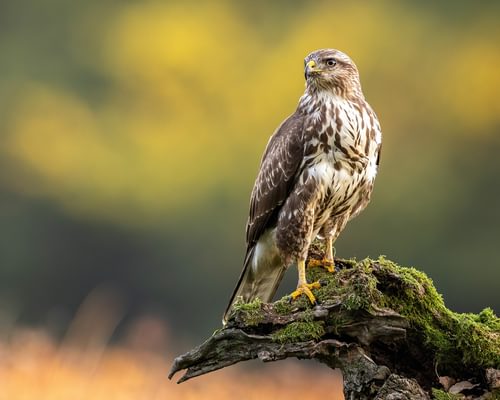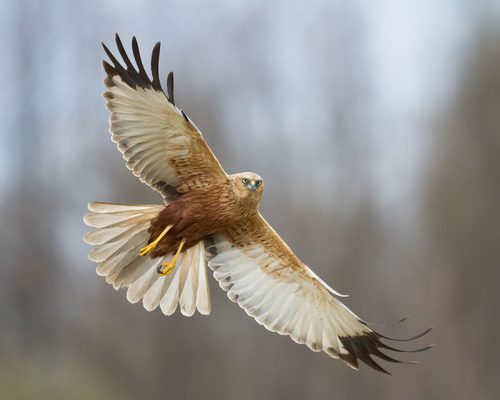Red Kite
Least ConcernMilvus milvus
Visual Identification
Appearance
The Red Kite is a striking raptor with distinctive rusty-red plumage, a deeply forked tail, and long, fingered wings. Its head is pale grey with a yellow, hooked beak, piercing yellow eyes, and legs.
Both sexes look similar, with females slightly larger, although behavioural differences best identify them. The bird's underwing shows white patches near the wingtips, visible during flight.
Juveniles are generally paler and have a less silvery head than adults. They also have a dark band across their tail and light streaking on their chest and belly.
Size
Length
60cm to 66cm
Wingspan
145cm to 165cm
Weight
800g to 1.3kg
Colours
Males and females have similar plumage
Primary Colour
Red Brown
Secondary Colour
Grey White
Beak Colour
Yellow
Leg Colour
Yellow
Habitat and Distribution
Habitats
Woodland
Garden
Wetland
Coastal
Urban
Farmland
Grassland
Desert
Tundra
Rainforest
Mountain
Savanna
Distribution
Red Kites inhabit a variety of open countryside, including mixed farmland with scattered woods. They are found across much of Europe, with strongholds in Germany, France, Spain, and the UK.
In the UK, they are most common in Wales, central and southern England, and parts of Scotland. Some northern European populations migrate to southern Europe or North Africa for winter.
Elevation Range
Up to 1,600 meters
Climate zones
Temperate, Mediterranean
Distribution Map
This map gives you a rough idea of where you might spot a Red Kite. The coloured areas show countries where these birds have been seen.
A few things to keep in mind:
- Birds might not be everywhere in the coloured areas, for example, they may be present around the coast of that country
- Where birds live can change with seasons and available food
- This map is quite simple - it doesn't show exact locations
We're working on making our maps even better! Soon, we hope to show you:
- More detailed maps for bigger countries, including state and region
- How birds move around during different seasons
Distribution by Region
Behaviour and Ecology
Bird Attributes
This feature is in beta. We'd love your feedback to improve it!
Share your thoughtsBird Attributes Explained
Our bird attributes system rates various aspects of a bird's capabilities on a scale of 0-100, based on data from field observations, scientific studies, and expert knowledge.
Attribute Categories:
- Agility: Manoeuvrability, speed, and grace in flight or movement.
- Strength: Physical power, often correlating with size and hunting abilities.
- Adaptability: Ability to thrive in various environments or changing conditions.
- Aggressiveness: Territorial behaviour and assertiveness, particularly during breeding seasons.
- Endurance: Stamina, often seen in migration patterns or foraging behaviours.
Understanding the Ratings:
- 0-20: Very Low
- 21-40: Low
- 41-60: Average
- 61-80: High
- 81-100: Very High
Remember, these attributes are relative to other bird species and don't necessarily indicate superiority.
Hover over the icon next to each attribute for more information.
Tap the icon next to each attribute for more information.
Agility
Reflects the bird's manoeuvrability, speed, and grace in flight or movement.
The Red Kite exhibits remarkable agility, known for its graceful, buoyant flight and ability to soar and glide with minimal wing beats. Their deeply forked tail and long, fingered wings contribute to their exceptional manoeuvrability in the air.
Strength
Indicates the bird's physical power, often correlating with size and hunting abilities.
While not the strongest raptor, Red Kites possess moderate strength suitable for their size and lifestyle. They can carry small prey and engage in food piracy, stealing from other birds, which requires a decent level of strength.
Adaptability
Represents the bird's ability to thrive in various environments or changing conditions.
Red Kites demonstrate high adaptability, thriving in various open countryside habitats and even frequenting rubbish dumps for food. Their opportunistic feeding behaviour and successful recovery from near extinction in the UK further highlight their adaptability.
Aggressiveness
Measures the bird's territorial behaviour and assertiveness, particularly during breeding seasons.
Red Kites are not particularly aggressive birds. They are social, often gathering in groups, and primarily scavenge rather than actively hunt. However, they do exhibit some aggression in food piracy and potentially when defending nests.
Endurance
Reflects the bird's stamina, often seen in migration patterns or foraging behaviours.
These raptors show impressive endurance, capable of staying airborne for hours with minimal effort. Their partial migratory behaviour in some populations and their ability to soar for extended periods indicate strong endurance.
Diet
Red Kites are opportunistic feeders. They primarily scavenge on carrion, mainly the carcasses of larger mammals and livestock, and smaller animals killed on roads.
They also hunt live prey, including small mammals, birds, rodents and invertebrates.
These adaptable raptors are known to frequent rubbish dumps and have been observed following farm machinery to catch disturbed prey.
Behaviour
Red Kites are known for their graceful, buoyant flight, often seen soaring and gliding with minimal wing beats. They are social birds, sometimes gathering in large groups of up to 100 strong at communal roosts or feeding sites (outside the breeding season).
These raptors are also skilled at food piracy, occasionally stealing prey from other birds.
Vocalisation
Red Kites are vocal birds known for their distinctive, high-pitched, rising and falling 'weoo-weoo-weoo' call. This mewing sound is often heard during flight or when interacting with other kites.
During the breeding season, they may produce a rapid series of 'wit-wit-wit' calls near the nest site.
Red Kites usually call when courting a partner or communicating with other members of their own species. They may also call if alarmed, excited, or distressed.
Nesting & Breeding
Red Kites form monogamous pairs, mating for life and returning to the same breeding grounds, where they typically breed from March to July. They engage in aerial courtship displays, with males presenting food to females mid-flight.
Nests are built in tall trees, often on woodland edges. They are a bulky structure of sticks lined with wool, grass, and other soft materials. Females usually lay 2-3 eggs, which are white with reddish-brown spots.
Incubation lasts about 31-32 days, primarily by the female. Chicks fledge after 48-50 days but remain dependent on parents for several more weeks.
Lifespan
The Red Kite typically lives for 10 to 26 years, with a maximum recorded lifespan of 38 years.
Like all birds, lifespan can be affected by factors including predation, habitat quality, disease, and access to food sources.
Conservation and Status
Global Conservation Status
Once critically endangered in the UK, Red Kites have made a remarkable recovery due to reintroduction programmes and protection efforts.
However, they still face threats from illegal poisoning, collisions with wind turbines, and habitat loss in some areas of their range.
Birdwatching Tips
- Look for their distinctive forked tail and reddish plumage when soaring
- Listen for their high-pitched 'weoo-weoo-weoo' call
- Visit known feeding stations in the UK, particularly in Wales and central England
- Scan open countryside and woodland edges, especially in the late afternoon
- They often fly with their wings flexed and their tails constantly twisting to angle against thermals, which they ride with a leisurely grace. To take advantage of thermals, the bird will rise late after waiting for the sun to warm the land.
Additional Information
Quick Facts
Other names:
Common Kite, Welsh Kite
Family:
AccipitridaePredators
Adult Red Kites have few natural predators, but eggs and chicks may fall victim to martens, crows, and other raptors. Ground predators can be a threat if nests are built too low.
Did You Know?
- Red Kites can live up to 26 years in the wild, though the average lifespan is much shorter.
- They were once 'royal birds', protected in medieval England and Wales.
- Red Kites are excellent flyers, able to stay airborne for hours with minimal effort.
- Red Kites very nearly went extinct from the current-day United Kingdom and were indeed extinct in England and Scotland. Their numbers dwindled to just fifty-odd pairs by the 1980s, and the decision was made to reintroduce birds from Sweden and Spain to bolster their population. Since then, they have increased dramatically, highlighting the change possible through conservation.
Was this bird profile helpful?
Your feedback helps us improve our content
Thanks for your feedback!
Your input helps us improve our content.
Community Experience
Community Ratings
No ratings yet - be the first to rate this bird!
Latest Community Reviews
No reviews yet
Sign in to be the first to review
Community Reviews
Create Your Free Account Welcome Back!
Join our community to rate birds and share your experiences. Creating an account is completely free and only takes a minute. Sign in to your account to rate birds and share your experiences with our community.
Your information is secure and will never be shared.
By creating an account, you agree to our Privacy Policy.
FAQs
Why do Red Kites sit in fields?
Red Kites prefer to hunt their prey from above. Although they will land in fields to forage for earthworms, collect food at feeding stations, or feed on carrion.
Why do Red Kites fly so high?
Red Kites are graceful in flight, preferring to soar than actively flap. They climb high into the sky with ease using rising air currents known as thermals and can reach impressive heights of 1600 meters above the ground.
Why do Crows chase Red Kites?
Carrion Crows and other corvids regularly chase Red Kites in a behaviour known as mobbing. The smaller crows are fearless and determined in chasing off kites, particularly in the breeding season when their chicks and even fledgelings are vulnerable to these birds of prey.
What are a group of Red Kites called?
The collective nouns for a group of red kites are as follows:
- Kites, a brood of red kites
- an eyrie of red kites
- a kettle of red kites
- a nest of red kites
- a roost of red kites
- a soar of red kites
- a stooping of red kites
- a string of red kites
Similar Birds
References
- 1
website, 2000: Carey and Judge, Longevity Records: Life Spans of Mammals, Birds, Amphibians, Reptiles, and Fish
View source - 2 3 4
website: BirdLife International. 2020. Milvus milvus. The IUCN Red List of Threatened Species 2020: e.T22695072A181651010.
View source

